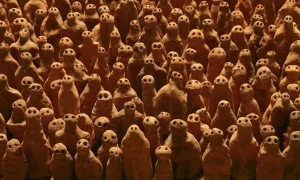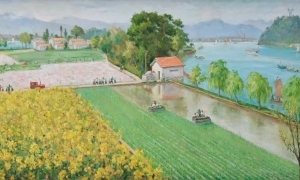张志成的近期作品主要包括人像和梦境两大主题。尽管从事绘画创作的人很多都是以此为题材,但张志成的创作却令人观看后难以忘怀和萦绕不散,究其原因在于他独特的油画语言表现力和对艺术之于现实关系的洞察力。作为一个从事艺术创作长达近三十年的艺术家,张志成具有极为深厚的油画技巧功底,早年深受塞尚绘画思想的影响。塞尚的绘画思想中最为核心的名言是“大自然的形状总是呈现为球体、圆锥体和圆柱体的效果”。由于这后来成了以毕加索、布拉克为代表的立体派的理论信条,所以理解这句话,对于理解塞尚的创作就显得格外重要。在我的理解中,塞尚并不是要把绘画理解为对物质世界的再现,不是像贡布里希所言要通过一个复杂得多的修正过程将原初简化了的图式逐步丰富,直到达到与现实物质世界的匹配。对于塞尚而言,他是要在对物质形象进行简化、提炼和删拨大要的基础上,致力于通过持续变化和不断调整的肌理来表达它们。持续变化和不断调整的肌理代替了通过形体结构和光影效果对现实物象的匹配,表达代替了再现,这才是塞尚绘画的重要元素。他的绘画不是对自然的单纯模仿,而是对其进行调整。不过,这种调整又有别于全然不顾现实物象的抽象构成或抽象表现,当然也有别于古典绘画的具像表现。张志成的早先绘画多是静物、花卉和人体,这些虽然都是现实世界的物理实存,但是张志成却不仅是要用自己头脑中的固定图式来整理现实中的对象,让其就范,而且是遵从于这些对象,接受这些对象变化的种种暗示,让自己自由地感受并且表达出物象存在的凝重的质感和量感。他画中的事物,虽然依稀存留了现实物象的线索,其实已跳脱了模仿与记录的性格,也排除了一般性的联想意义。
绘画语言表现力对于张志成而言,不仅体现在他对现实物象的简化、提炼和删拨大要,而且还体现于他对画面色彩大胆、主观但又完美的使用和表现,而这在我看来,也同样受到塞尚的很大影响和启发。对塞尚来说,绘画是一桩通过色彩来呈现或者说实现现实对象的事情,实际上,他对物象的理解和表现,恰恰是在其创造性的对色彩系统的使用方法下实现的。从早期对光影效果的浓厚兴趣,试图通过阴影的渐变和肌理质感效果来勾画出三度空间中的体积感与实质感,到1990年代以后色彩上单一化趋向的出现,张志成逐渐地走向纯粹色彩的抒情表现。线条的使用和光影效果的营造,所要达到的三度空间的幻觉,被大面积的带有持续变化和调整的单色调肌理所取代,而色彩的纯化往往产生出色彩取代光成为造型手段的奇异效果。
近年来张志成以人像和梦境为主从事创作,前者口、鼻、眼、耳等五官特征按照传统油画的原则,需要调和许多种色彩来表现;后者非真实的人与物、物与物甚至人与人的空间关系,也依赖多种表现手段的齐头并进。然而令人诧异的是,张志成竟然能以三两种有时甚至是一种色调来表达画面形象并且格外精彩。他的画最初给观看者的印象是鲜丽响亮的色彩调子,明度和纯度都很高,彷佛张志成是一个性格奔放和外向乐观的艺术家。其实,在这种鲜亮的色彩被反复覆盖和持续附着的背后,你总是能感受到这些人物孤独落寞的情绪。在这里,色彩不仅担当起了造型的职能,而且还起到反衬画面主题情绪的作用。也就是说,尽管单色调是他绘画创作的主轴,尽管色彩的明度和彩度都非常耀眼,但它们并不轻佻和浮夸。因为单色块状作为积体,因为同一色阶块状积体的交迭和不断调整、涂抹的层层肌理,物象被覆盖了,观看者通往现实实存的路径被堵塞了,可同时物象却又被抽离出我们以为它原本应该存在的那个现实背景,被悬浮于画面的某个位置。这个位置既是张志成所要寻找的,也是我们观看者所要寻找的,它就在画面里,它在期待着我们的发现,就像这些窥视着我们的人像一样,它也窥视着我们。
因此,张志成对色彩单色化的选择和处理,绝非仅仅是对某些色彩的偏爱,应该把他在色彩上多年努力和精湛的表现,理解为他要赋予色彩以独立的物质化地呈现现实世界的能力。因此,在他的画中,色彩是一种物质,是一种媒介,它的反复堆栈和铺陈所造成的突现与退隐的视觉效果,是为了取代光影而记录下时间中物象的变化——对于人物是生命浮沉,对于景物是生长盛衰。
考察张志成的绘画历程,常常会有这样的困惑:尽管他的创作是来自对真实视觉感受的诠释,特别是他近来的人物形象绘画,都是取材于现实生活里到处充斥的印刷品图像或者身边的朋友影像,他就应该算是一个现实主义者吗?与此相反的问题是,他的梦境题材的创作因为来自非现实的自然世界,那么,他是否还有理想主义的倾向?我以为,张志成绝不是一个模仿自然或者还原自然的现实主义者,但是,他也绝不是回避现实的理想主义者。在北京这个超大型的城市里,在物与物的关系极大地遮蔽了人与人的关系的这个社会现实里,无视现实显然是难以做到也没有理由做到的。问题在于,在北京生活的这几年,在张志成的绘画里的确出现了大量的人物形象,虽然这些形象绝非这些年风靡的带有特定社会特征的形象,但是,它们依然反映了艺术家本人对中国大陆时下的社会现象的注意,只不过艺术家本人多年来的艺术观念使他能够从容做到基于现实而不受限于现实。从张志成的新近画作看,现实生活本身的感受,促使他用自己日臻娴熟的色彩肌理构成的造型语言来开拓新的题材,让色彩的表现力面对新的挑战,创造新的可能。张志成的新近创作,一如他以往的实践那样,与现实世界是不可彼此还原和隶属的。绘画,对于张志成来说,属于一个精神的世界,与现实世界是平行的。而张志成的绘画对于我们观看者来说,则让我们相信绘画今天仍然具有难以言表的可能性和魅力。
高岭
2009-10-8
Paintings as Independent Objects
——Chang Chih-Cheng’s Recent Works
Gao Ling
2009-10-8
Chang Chih-Cheng’s recent works are of two major themes—portraits and dreams. What makes Chang’s works unforgettable and lingering among the myriad of other artists’ works of the same subjects is his unique expressiveness in oil painting and a keen insight into the relationship between art and reality. As an artist whose career has spanned over 30 years, Chang has built a solid foundation in oil painting techniques, and was greatly influenced by Paul Cezanne in early years. “To treat the nature by the cylinder, the sphere, the cone” lies at the core of Cezanne’s art, and later became the theoretic principle of Picasso and Braques’ Cubism, making it essential to understand the famous dictum in the appreciation of Cezanne’s works.
In my understanding, Cezanne did not perceive the painting as a re-creation of the visible world, as Gombrich’s observation that it is a gradual enrichment of a simplified pictorial object through a much more complex correctional process until it matches the object in the real, material world. Cezanne aimed to portray objects with continuously changing and modifying textures, through the process of simplification, refining and extracting the essence. The continuously changing and modifying textures replace trying to depict objects using structural composition and light and shadow effects, and impression replaces reproduction. That is the central element in Cezanne’s art. His paintings are not simply imitations of nature, but modifications of it. However, this modification differs from abstract expressionism, which disregards entirely the appearance of the real object, and clearly differs from the realistic quality of classicism. Chang Chih-Cheng’s earlier paintings consisted of mainly stills, flowers and nudes. Although these are all real physical objects, Chang not only organized them according to designated symbols in his mind, but also obeyed and accepted the changing qualities in these objects, allowing himself to freely sense and convey the quality and substantiality of these objects. The objects in his paintings, although seemingly containing traces of reality, have in fact transcended the purpose of imitation and archiving, and eliminated commonly associated meaning of these objects.
To Chang Chih-Cheng, his artistry does not only manifest in the simplification, refining and extraction of essence of real life objects, but also in the bold, subjective and yet perfect application of colors. To me, that is also an influence by Cezanne, to whom painting is an act of presenting or realizing real objects through colors. Coincidentally, Cezanne’s understanding and expression of objects came as a result of his creative application of the color system. From Chang’s attempts to create a 3-dimentional sense of volume and substance that stemmed from a profound interest in light and shadows in his early years, to a preference for monochromatic expression after the 1990’s, Chang has gradually progressed towards a sentimental expression of purely colors. The use of lines and shadowing effect to achieve the illusion of three dimension is replaced by large areas of continuously changing monochromatic texture, a method that usually manages to create surprising effects.
In recent years Chang has focused mainly on portraits and dreams for his work. In the former, facial features are depicted with a mixture of many colors, according to traditions in oil painting. In the latter, the subject matter is based on the various combinations of relationships between unreal people and objects, and relies on a mix of techniques to convey the story. But what is really surprising is Chang’s ability to convey the image with only two to three hues, sometimes even one, and to fantastic effects. At first his paintings give the viewer the impression of a vibrant and lively color palette that is high in brightness and purity, portraying Chang as an artist of an extroverted and optimistic disposition. In fact, delving deeper behind the repeated and overlapping application of these bright hues, one can always sense loneliness in these characters. Here color not only assumes the role of the stylist, but also produces the effect of setting off by contrast the emotions conveyed by the image. In other words, in spite of a monochromatic theme and the high level of brightness and purity of the colors used, they do not come off as frivolous and flamboyant. Objects are covered by overlapping monochromatic color blocks and constantly changing textures, and thus viewer’s path to realism is block, but at the same time objects are extracted from the presumed reality, and are suspended in place in the image. This place, sought by Chang and by us as viewers, exists in the image and waits to be discovered. Like the people who are spying on us, it is spying on us as well.
Therefore, Chang’s selection and treatment of a monochromatic treatment is definitely not a sign of preference for certain colors. Instead, we should interpret his longtime efforts and excellent work of color as attempts to give colors the ability to exist independently as objects in the portrayal of the real world. Therefore in his works, color is a substance and a medium. The suddenly appearing and disappearing visual effect achieved by the overlapping and narration of colors is meant to replace lighting and shadows and to document the changes in objects over time—in humans the ebb and flow of life, in things the rise and fall.
Looking at Chang Chih-Cheng’s painting career, one often questions whether he should be classified as a realist simply because his creations come from his interpretation of real visual sensations, especially his recent portraits which are based on printed pictorials or photographs of his friends. The opposing question is whether he is an idealist because his works on dreams are based on a non-real world? I believe that Chang is not a realist who imitates or restores nature, nor a reality-escaping idealist. In a metropolis like Beijing, a social realism where things and objects greatly overpower human relationships, it is obviously impossible and senseless to disregard reality. The issue is that the number of portraits has significantly increased in Chang’s works during his years in Beijing. These character images are definitely not like those carrying specific social symbols, which have become popular in art in recent years, but they still reflect the artist’s observations of the social phenomena in China today. The artist has effortlessly stayed true to reality but is not limited by it, due to his own artistic philosophy built over the years. Judging from his recent works, his experience of reality has prompted him to explore new subject matters with his maturing color usage, and allowed him new challenges and possibilities with his colors. Like he has always done, his works are not interchangeable with the real world, nor do they belong to the real world. Painting to Chang Chih-Cheng is a spiritual world, parallel to the real one. And to us, it allows us to believe that paintings still possess possibilities and charms indescribable in words.
【编辑:霍春常】





















